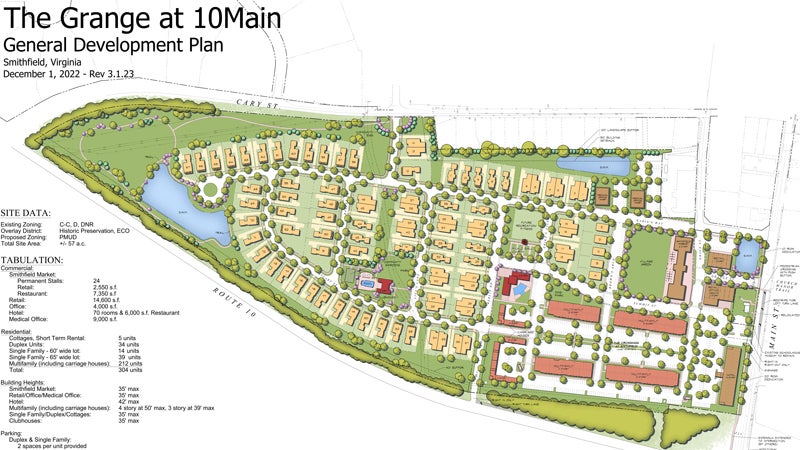Smithfield planner questions public funding for ‘Grange’
Published 3:43 pm Thursday, April 13, 2023

- A plan for the Grange, dated March 1, shows the Schoolhouse Museum staying at its current location. Prior plans had called for moving the museum 200 feet closer to the corner of Main and Grace streets.
Dr. Thomas Pope, a member of Smithfield’s Planning Commission, finds it “odd” that the Grange at 10Main’s developers plan to seek an unspecified dollar amount from the town in exchange for extending utilities to an indoor/outdoor farmers market that would anchor the development.
Grange developer Joseph Luter IV, son of former Smithfield Foods Chairman Joseph Luter III, appeared before the Planning Commission on April 11 for his first official presentation on the development to the eight-member body. The meeting also served as the commissioners’ first opportunity to ask questions of Luter IV, who filed an application in December seeking mixed-use zoning for the Grange, named for its location at Route 10 and Main Street.
The elder Luter purchased and razed the former Little’s Supermarket and 1730s-era Pierceville farmhouse in 2020, proposing in 2021 to turn the nearly 57 acres into a development that would include a permanent home for the town’s farmer’s market, a hotel, three- and four-story apartment buildings, single-family and duplex homes and commercial space.
Luter IV’s application asks that the land be rezoned as “PMUD,” an acronym for the “planned mixed-use development” option Smithfield’s Town Council voted in 2022 to add to its zoning ordinance.
The Luters, according to a 2022 fiscal impact analysis by Ted Figura Consulting, are also requesting Isle of Wight County and Smithfield jointly purchase and operate the new market building, provide an “economic development incentive for the hotel” and “purchase the development’s infrastructure and utilities through a participation agreement.”
The cost of extending public utilities to a new development is “normally donated” by the developer to the town, Pope contended.
“We didn’t do that with Mallory Pointe,” Pope said, referring to the 812-home development being built on the former Mallory Scott Farm off Battery Park Road. Last month, the Planning Commission approved Mallory Pointe developer Napolitano Homes’ proposal to replace an 8-inch-wide water main serving Battery Park Road with a new 16-inch pipe, which will be installed in a public right-of-way along the street. Smithfield Town Manager Michael Stallings confirmed to The Smithfield Times that Napolitano is funding 100% of the expansion’s cost.
“I don’t understand … me as a taxpayer … paying to put in utilities for a developer,” Pope said.
Town Attorney Bill Riddick contended that when a developer installs water and sewer infrastructure in areas of town “not previously served” by public utilities, the developer is “entitled to a credit,” typically via a discount on the utility connection fees the developer would otherwise pay the town.
“The law doesn’t allow us to require a developer to put in more than is required for their development, and if we require that because we need the extra capacity, then we essentially have to pay,” Riddick said.
Luter IV told the commissioners he planned to seek “reimbursement” for costs associated with the “public” components of the Grange, including roads, utilities and parking associated with the market and planned pickle ball courts, but would not be seeking reimbursement for the “private” areas.
Stallings told the Times he was “not aware” of any developers having sought the reimbursement option in the past, though the Grange, if approved, would be the town’s first mixed-use development under the new PMUD zoning option.
Luter IV, in an email to the Times, said he and his design team “don’t know yet” the cost to the town of extending utilities to the Grange or the cost of the “economic development incentive” for the hotel.
The amount of taxpayer money that would effectively subsidize the cost of building the Grange became a point of controversy last year when the elder Luter offered land and a $1 million contribution toward building the market conditioned on Smithfield and Isle of Wight County jointly raising another $2.7 million for the project. Last fall, the Smithfield Town Council and Isle of Wight supervisors each voted to contribute up to $1.4 million toward moving the farmers market to the Grange. The council’s vote followed a closed-door meeting for the stated purpose of “contract negotiations.”
Two other planning commissioners – Julia Hillegass and Jim Yoko – each wanted to know during the April 11 meeting whether the expense of constructing the brick market building would increase the cost of a booth at the Smithfield Farmers Market beyond what its regular vendors have become accustomed to paying for space in the Bank of Southside Virginia’s parking lot, where the market is currently held on Saturdays.
“A lot of these vendors that are there today are there because there’s not a huge fee for being part of the market,” Yoko said. “With the price that’s required to build the building … I would imagine that the rental price for that is going to come up.”
Commissioner Randy Pack, who has recused himself from discussing or voting on the Grange because of his family’s business interest in running one of the Grange’s proposed restaurants or the hotel, called Smithfield-Isle of Wight Tourism Director to the lectern to speak to the farmers market pricing. Winslow stated the farmers market is “not in the business” of pricing vendors out of participating. In addition to the 24 indoor vendor booths proposed for the building, there would be 16 covered outdoor booths and the roughly 1.3-acre “village green” park adjacent to the building for tents, much like the current market setup.
Traffic, high-priced homes draw residents’ concerns
The Grange would have 304 total residential units, including 212 apartments, 34 duplex units, 53 single-family homes and five short-term rental cottages. The total is roughly double the 151 units a previous developer proposed for the former Pierceville farm in 2015.
The commissioners plan to hold a May 9 public hearing on the Grange but were already hearing commentary from residents on the matter during the April 11 meeting’s public comment period – namely over traffic concerns and whether the Grange would alleviate or worsen Smithfield’s lack of affordable housing.
“I daydream some days about being an empty-nester with two adult children still at home. … It bothers me that if my kids wanted to stay in this general area they might have to look to Franklin or Southampton County, and then commute back into Smithfield,” said Leigh Abbott Leaman.
The hotel and high-priced homes would fill “many of the current voids, including Class A housing, both for rent and for sale,” Luter IV told the commissioners.
“Class A,” in the real estate market, refers to the most expensive homes with high-end finishes in the most desirable neighborhoods. According to Figura’s analysis, the apartment rental rates would range from $1,475 per month for a one-bedroom unit to $2,100 per month for a three-bedroom “carriage house” apartment – well above the median $985 monthly gross rent the U.S. Census listed for Smithfield for 2017 through 2021.
“We would not be here today with this ambitious plan if we did not have the support of Smithfield Foods,” Luter IV said, calling the global pork giant the “primary economic engine” for the town and county.
“We all have a collective responsibility to ensure we can provide the type of amenities they need. … The town of Smithfield’s lost over 400 jobs to neighboring cities because we lacked such amenities,” Luter IV said.
Bill Harris, a resident of Grace Street, asked the commissioners to deny the Luters’ request to use the two-lane residential road as an access into the Grange. According to a traffic study by Virginia Beach-based McPherson Consulting, submitted with the Luters’ application, the Grange would add over 2,700 vehicle trips per day to Smithfield’s roads. The study estimated 15% to 25% would access the development via Main Street and 2% to 5% would use its Grace Street or Cary Street connectors. Pope, at one point, proposed requiring a speed bump at the Grange’s Grace and Cary street entrances, but Riddick said that “under no circumstances” would the Virginia Department of Transportation allow a speed bump on “a major street.” Grace Street is designated as an alternate route for U.S. Route 258 and Cary Street becomes Mill Swamp Road, also known as State Route 626.
Grace and Cary streets are each owned and maintained by VDOT, not the town, Riddick said. Pope then asked for the developers to look into the Grange entrances becoming four-way-stop intersections.
A 2018 VDOT traffic calming guide for neighborhood streets recommends “speed lumps” for roads that serve as primary emergency or transit routes, which contain breaks in the bump to facilitate easier passage by bicyclists and emergency vehicles.
Under state law, the Planning Commission has up to 100 days to vote on a rezoning application – in this case, until July 20. If no vote is taken by that date, the application moves to the Town Council with an automatic recommendation for approval.





